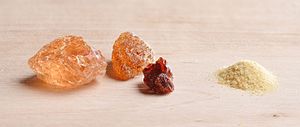Note: This is a project under development. The articles on this wiki are just being initiated and broadly incomplete. You can Help creating new pages.
Vachellia nilotica - Gum arabic
Vachellia nilotica also known as acacia gum, is a natural gum consisting of the hardened sap of various species of the acacia tree. Originally, gum arabic was collected from Acacia nilotica which was called the "gum arabic tree". In the present day, gum arabic is predominantly collected from two related species, namely Acacia senegal and Vachellia (Acacia) seyal.
Uses
Parts Used
Chemical Composition
The plant yields a gum containing arabin as the chief constituent. Other constituents of the gum include tannic and gallic acids, cresol (an antiseptic), methyl salicylate, complex salts of calcium, magnesium and potassium, galactose, l-arabinose, l-rhamnose and 4 aldobiouronic acids[1]
Common names
| Language | Common name |
|---|---|
| Kannada | Babli |
| Hindi | Babool |
| Malayalam | Karivelam |
| Tamil | karuvelai |
| Telugu | Nalla tumma |
| Marathi | NA |
| Gujarathi | NA |
| Punjabi | NA |
| Kashmiri | NA |
| Sanskrit | |
| English | Gum Arabic |
Properties
Reference: Dravya - Substance, Rasa - Taste, Guna - Qualities, Veerya - Potency, Vipaka - Post-digesion effect, Karma - Pharmacological activity, Prabhava - Therepeutics.
Dravya
Rasa
Kashaya (Astringent)
Guna
Ruksha (Dry), Guru (heavy)
Veerya
Sheeta (cold)
Vipaka
Katu (Pungent)
Karma
Kapha
Prabhava
Habit
Identification
Leaf
| Kind | Shape | Feature |
|---|---|---|
| Simple | Petiole | The twice-compound (i.e. bipinnate) leaves are dark green in colour and have a feathery appearance |
Flower
| Type | Size | Color and composition | Stamen | More information |
|---|---|---|---|---|
| Unisexual | 6-15 mm | Yellow | 5-20 | Flowers are densely arranged into small globular clusters and flowering from March to July |
Fruit
| Type | Size | Mass | Appearance | Seeds | More information |
|---|---|---|---|---|---|
| Elongated pod | 6-25 cm long | These greyish-green pods are covered in tiny soft hairs | With hooked hairs | - | {{{6}}} |
Other features
List of Ayurvedic medicine in which the herb is used
- Vishatinduka Taila as root juice extract
Where to get the saplings
Mode of Propagation
How to plant/cultivate
Gum arabic succeeds in subtropical to tropical lowland areas and at elevations up to 1,300 metres[303 ]. It thrives in areas with an annual rainfall in the range of 400 - 2,300mm[3]
Commonly seen growing in areas
Photo Gallery
References
External Links
- Ayurvedic Herbs known to be helpful to treat Dysentery
- Ayurvedic Herbs known to be helpful to treat Leprosy
- Ayurvedic Herbs known to be helpful to treat Cough
- Ayurvedic Herbs known to be helpful to treat Intestinal pains
- Ayurvedic Herbs known to be helpful to treat Cancer
- Ayurvedic Herbs known to be helpful to treat Tumours
- Ayurvedic Herbs known to be helpful to treat Pimples
- Ayurvedic Herbs known to be helpful to treat Diarrhea
- Ayurvedic Herbs known to be helpful to treat Chest problems
- Herbs with Bark used in medicine
- Herbs with Pods used in medicine
- Herbs with Gums used in medicine
- Herbs with Leaves used in medicine
- Herbs with common name in Kannada
- Herbs with common name in Hindi
- Herbs with common name in Malayalam
- Herbs with common name in Tamil
- Herbs with common name in Telugu
- Herbs with common name in English
- Habit - Tree
- Index of Plants which can be propagated by Seeds
- Herbs that are commonly seen in the region of Woodlands of various sorts
- Herbs that are commonly seen in the region of Wooded grasslands
- Herbs that are commonly seen in the region of Scrub and thickets
- Herbs
- Repeat plant
